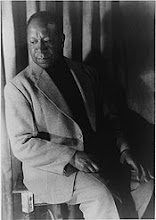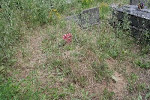I recently received notification that the Nevada Museum of Art would include work by Beauford in its exhibition entitled When Langston Hughes Came to Town.
I immediately went to the museum's Website to see what information I could find about the premise of the show and why Beauford is being included in it.
The copy on the Web page indicates that the exhibition will be divided into three parts that explore:
1) Hughes' relationship with the State of Nevada
2) Work created by leading artists of the Harlem Renaissance who had close ties to Hughes
3) Contemporary artists who were inspired by Hughes and made work about his life
A slider near the bottom of the page shows Beauford's portrait of Ella Fitzgerald as one of the works to be displayed in the show.
Portrait of Ella Fitzgerald
(1968) Oil on canvas
Permanent collection of the SCAD Museum of Art, Savannah
Gift of Dr. Walter O. and Mrs. Linda J. Evans
© Estate of Beauford Delaney
by permission of Derek L. Spratley, Esquire,
Court Appointed Administrator
Beauford's name is mentioned in reference to the artists of the Harlem Renaissance with whom Hughes had close ties.
Not being familiar with any close relationship between the two men, I set out to investigate what this might have entailed.
I did not find any mention of Beauford in either of the two volumes of The Life of Langston Hughes, a biography by Arnold Rampersad.
I only found a few mentions of Hughes in Amazing Grace: A Life of Beauford Delaney by David Leeming, the only Beauford Delaney biography that currently exists.
Leeming says that Beauford encountered Hughes at "the old stable at 306 West 141st Street" in Harlem, which was known simply as "306" by the Black intellectuals who gathered there.
He says that Beauford read "whatever was published in journals by Langston Hughes."
And he mentions that Hughes attended the party celebrating the production of James Baldwin's The Amen Corner in Paris in 1965, which Beauford attended as well.
In 1948, Hughes authored the radio transcripts for an NBC summer replacement series called Swing Time at the Savoy, which was recorded at the Savoy Ballroom in Harlem. Ella Fitzgerald and her then husband, Ray Brown performed there on July 28, 1948.
I reached out to the museum to request information to supplement my findings.
Director of Communications Valerie Primeau responded, informing me that Beauford's portrait of Fitzgerald will be the only work of his in the exhibition.
She also said:
"Although Langston Hughes and Beauford Delaney were prominent figures during the Harlem Renaissance and had shared mutual respect for their art practices, documented interactions are limited.
"This portrait of Ella Fitzgerald was selected because she is one of the greatest jazz vocalists who often performed in the Savoy Room during the period before receiving her major break in the 1930s at the Apollo Theater. Her iconic voice, visually presented with the bold application of color, shows how she illuminated concert halls and jazz venues.
"Merging the histories of these three artists envelops Hughes’s appreciation of jazz and blues and core expressions of Black Life."
When Langston Hughes Came to Town opens today - May 3, 2025.
It will be on display through February 15, 2026.














